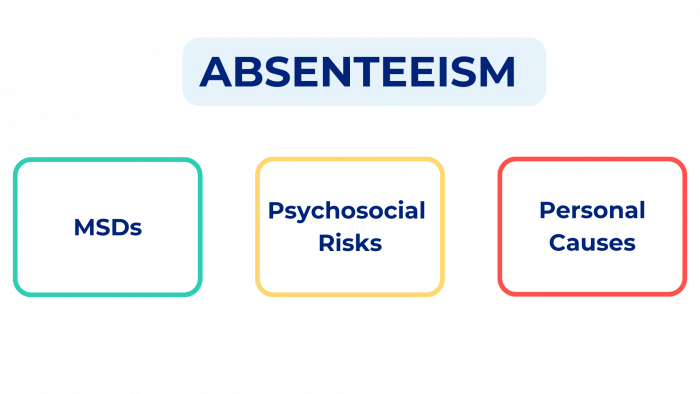Employee absenteeism: Why are so many employees absent?
It’s getting on the nerves of HR managers, executives, and occupational health services. Who is it? Absenteeism, of course! Since 2016, the absenteeism rate has been steadily increasing in companies: from 4.8% in 2019, workplace absenteeism in France rose to 5.5% in 2021. According to the Verlingue study, its level is expected to be the same or higher in 2022. Absenteeism affects all sectors, both public and private.
Moovency aims to decipher the phenomenon by reviewing the causes of absenteeism in the workplace.
Workplace Absenteeism, a Growing Phenomenon
Definition of Workplace Absenteeism
The Anact-Aract network, a public organization specializing in occupational health issues, defines absenteeism as “any absence that could have been avoided through sufficiently early prevention of factors leading to deterioration of working conditions, broadly understood physical environments but also work organization, quality of employment relationships, reconciliation of professional and private time, etc.”
This definition directly links the phenomenon to the quality of working life.
There is thus a distinction between absences independent of the company, such as those related to seasonal illnesses or private causes, which are not problematic in themselves, and absences where work is directly affected by absenteeism. Therefore, attention must be paid to the functioning of the company, workload, and working conditions to reduce absenteeism.
Key Figures of Workplace Absenteeism
- An employee is absent for an average of 38 days per year.
- Since 2017, absenteeism has increased by 37%.
- 83% of absences are related to illness, and 17% are caused by workplace accidents.
- In 2021, long-term absences accounted for 60% of days lost.
- An absent employee costs the company an average of €85 for salary maintenance. Annually, the cost of absenteeism is €3,293 per absent employee.
- The sectors most affected by absenteeism in 2021 are healthcare (7.7%), agri-food (7.1%), and commerce (5.8%).
- The absenteeism rate for workers and employees is on average higher nationally than that of executives and supervisory staff (7.1% vs. 3.1%).
Days per year
of absences related to illness
cost of absence
The Causes of Absenteeism
Workplace absenteeism has well-known causes: musculoskeletal disorders, psychosocial risk factors, and personal reasons.

Issue #1: Musculoskeletal Disorders (MSDs)
The primary cause of absenteeism has always been associated with MSDs, musculoskeletal disorders. MSDs occur when workstations are not properly adapted. Biomechanical constraints caused by poor posture, repetitive movements, force, and duration of activity can strain muscles, tendons, and joints.
Statistics
By the end of 2018, over 23% of sick leave was due to musculoskeletal disorders.
Acute low back pain is the second most common reason for consultation with a general practitioner. It accounts for 30% of sick leave exceeding six months and is the third leading cause of disability for the general scheme.
Issue #2: Psychosocial Risks (PSRs)
When certain work situations are unpleasant for an employee, causing stress or exposing them to violence, they may experience physical and psychological symptoms leading to absences.
All these risk factors are collectively referred to as psychosocial risks (PSRs). According to the criteria established by Gollac, a system for assessing and monitoring employees’ mental health, six risk factors are identified:
- Emotional demands.
- Lack of autonomy.
- Poor quality of social relationships at work.
- Ethical suffering.
- Insecurity of the work situation.
These factors should be considered as a whole, and it is recommended not to study them separately.
Statistics
- The cost of work-related stress is estimated to be between 1.9 and 3 billion euros in France (2010).
- 45% of workers say they often must hurry.
- 30% report experiencing hostile behavior in the workplace over the past year.
- 9% report having to do things they disapprove of.
Issue #3: Personal Causes
Illness, difficult life circumstances, caregiving responsibilities: there are many personal reasons that can lead to an employee’s sick leave.
Even though, unlike MSDs and PSRs, the company is not directly responsible for these absences, this reason for absence negatively impacts the employer with an increase in the absenteeism rate. This is why some companies implement targeted actions to support employees facing challenges in their personal lives.
Conclusion
The causes of absenteeism in the workplace are manifold (and sometimes cumulative): musculoskeletal disorders, psychosocial risks, personal reasons. Companies have a role to play.
Measuring the phenomenon internally is the first step in a broader prevention plan aimed at reducing repeated absences.
Efforts should be directed towards improving working conditions to reduce absenteeism and providing better support for employees upon their return to work to prevent further absences.
Sources :
• 14e Baromètre de l’absentéisme et de l’engagement : quand la crise sanitaire devient une crise de l’engagement au travail, AG2R La Mondiale et Ayming, 2022
• “L’absentéisme en France poursuit sa hausse : + 37% en 4 ans”, Culture RH
• “Verlingue publie son 1er Baromètre Absentéisme”, Verlingue, 2022.
